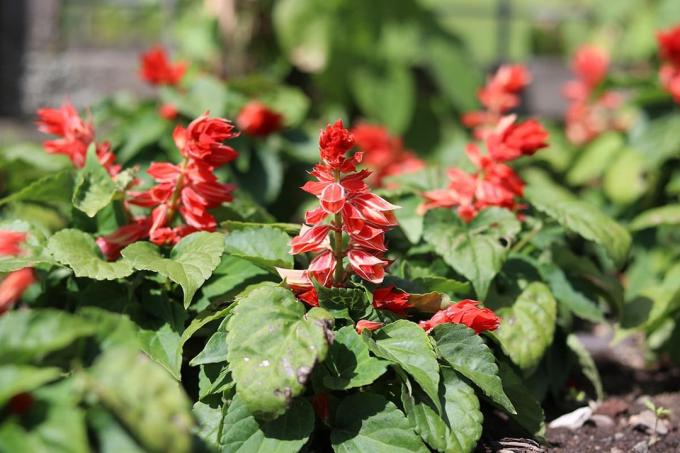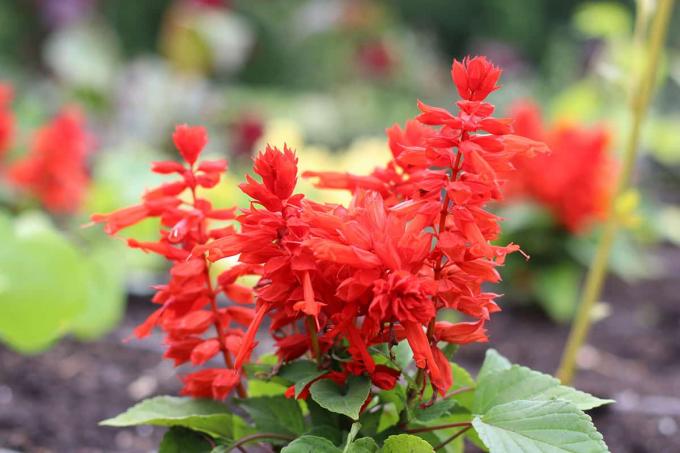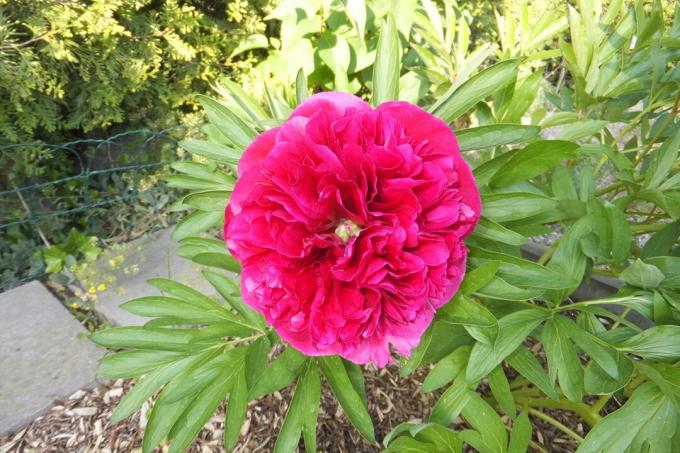

Table of contents
- Characteristics
- Location
- substrate
- Pour
- Fertilize
- waste
- Propagation by seeds
- Propagation by shoot tips
- tub culture
- wintering
- Pests, diseases, care mistakes
The fire sage impresses with its bright colors and panicle-shaped flowers, but it also needs the right care and factors. We show what is important.
Characteristics
- comes from Brazil
- an average of 20 to 30 centimeters high
- panicled flowers
- available in different colors
- Growth habit is compact
Location
The fire sage needs a sunny, sheltered location. Although it also thrives in partial shade or shade, it does not then reach its full flowering potential. The flower color can also be paler.
It is also important to protect against:
- hail
- heavy rain
- wind
The south and east side prove to be optimal, close to a house wall, wall or fence. Larger plants that do not provide too much shade but absorb stronger winds can also be useful.
substrate
Choosing the substrate for Salvia splendens is extremely easy, because normal potting soil or fresh garden soil is sufficient. The substrate should still meet some requirements. Below:
- good water retention
- no tendency to compaction and waterlogging
- loose consistency
- moderate nutrient content
A notice:
With very dense plant or garden soil, it may be necessary to loosen the substrate with sand or coconut fibers. In addition, foreign objects such as roots and stones should be removed.
Pour
Salvia don't need a lot of water, but they are sensitive to waterlogging. This means that the substrate can be kept slightly moist at all times, but drying out is easily tolerated, at least for a short time.

Tip:
In order to avoid waterlogging, it is advisable to introduce a drainage layer in the planter. Coarse gravel or shards of pottery at the bottom of the pot or bucket are ideal.
Fertilize
The fire sage does not require large amounts of nutrients, but regular fertilization can increase the flowering power. It is therefore advisable to supply nutrients, especially in the case of perennial culture in the tub.
A simple fertilizer for flowering plants is suitable. This should be added to the irrigation water once a week, but no more than half a dose.
waste
A blend is not absolutely necessary with the Salvia splendens, but it has some advantages. Blending is recommended in the following cases:
- right after the flowers wither
- for damaged plant parts
- during new sprouting in spring
By directly removing the dried flowers, a further flowering phase can be stimulated. Cutting off withered or otherwise damaged plant parts, on the other hand, reduces the susceptibility to pests and diseases. A blend during sprouting ensures that the plant grows particularly dense and voluminous.
Propagation by seeds
The propagation of seeds is extremely easy with the Salvia. The seeds can be sown or brought forward as early as February. The following steps are useful for this:
choose substrate
Potting soil, herbal soil or a simple standard soil are perfectly sufficient for germination. The substrate should be slightly damp but not wet.
sowing
The seeds are lightly pressed into the soil about five centimeters apart. It is then sufficient to cover the seed with a layer of about three millimeters of substrate.
humidification
For moistening, the soil can be carefully poured with low-lime water or sprayed with it.
Location
A bright location without blazing sun is optimal for germination. The temperature should be around 20 degrees Celsius.
cover
With a glass plate, a transparent film or a greenhouse, the soil is kept slightly moist without frequent watering and germination is encouraged. However, the chosen cover should be aired daily to avoid the formation of mold.
After about one to two weeks, the first shoots should be visible. When these are about five centimeters high, pricking can take place. The plants are removed individually and placed in larger containers. Especially weakly growing Salvia can be removed directly.
Tip:
Heating the substrate to at least 100 degrees Celsius in an oven or microwave ensures that germs such as fungal spores are killed. Pests also don't stand a chance due to the heat treatment.
Propagation by shoot tips
Another way of propagating fire sage is to obtain shoot tips. These can be cut off with clean, sharp scissors.
They are then plugged into potting soil or simple garden soil. This should also be kept slightly moist at all times. The planter must be bright and warm.

tub culture
Salvia splendens can also be grown wonderfully in a bucket. This has the advantage that the plant, which is otherwise cultivated as an annual, can be easily overwintered and preserved for several years. However, a few points must be observed in order to keep the plant strong and to avoid diseases and pest infestation.
This includes:
- Insertion of a drainage layer
- more frequent watering
- annual repotting
- safe and secure location
- stable planter
- weekly fertilizing
Since the plant has less substrate available, the stores for liquid and nutrients are also lower. At the same time, care must be taken to avoid waterlogging.
Tip:
The plant can also be planted outdoors with a planter. As a result, more soil is available and wintering can still be done comparatively easily indoors.
wintering
Although the fire sage with the eye-catching flowers is usually only cultivated outdoors for one year, Salvia splendens is a perennial plant. However, it is not winter hardy.
Nevertheless, hibernation is extremely easy, especially when cultured in a bucket. Only the following factors need to be considered:
- as bright a location as possible
- allow the upper substrate layer to dry thoroughly between waterings
- Regular checks for diseases and pests
- Temperatures between five and ten degrees Celsius
In addition, care should be taken to ensure that fertilization is stopped by September at the latest. This allows the plant to prepare accordingly for winter dormancy. Waterlogging is urgently to be avoided.
Pests, diseases, care mistakes
Pests are not to be expected with the flowering sage. However, rot and mold are just as common as other fungi. These are usually due to care errors. These include, among others:
- wrong location
- lack of drainage
- dammed water
- inferior earth
- Do not remove withered plant parts
- Use of hard water
- too frequent watering
Whenever excessively wilted plant parts appear, the soil smells unpleasant or changes color, the care conditions should be checked carefully. Because problems with the plant often arise due to deficiencies in the culture and can therefore often be easily remedied.
 garden editorial
garden editorial I write about everything that interests me in my garden.
Learn more about perennials

20 hardy plants that bloom all year round
With plants that flower all year round, you can quickly create an attractive garden that does not require much maintenance, as long as the plants are also hardy. In this post, we will introduce you to 20 plants that are suitable for this.

17 flowering hardy plants May to October
Many plants only show their full splendor for a short time. But there are also types and varieties with a particularly long flowering period from May to October, sometimes even longer. We present 17 flowering hardy plants.

Hardy perennials: 22 perennial bloomers
Hardy perennials as permanent bloomers in the flower bed enchant the garden from early summer to autumn with a colorful bloom. They are easy to care for and magically attract butterflies, bees and the like.

10 care tips for the banana tree
If you like it exotic, cultivate a banana tree as a houseplant or in the conservatory. In summer, the banana plants are even allowed outside for a few weeks. The large leaves that the Musa forms on a false trunk are particularly decorative and impressive, and therefore look like a small tree.

Properly care for globe thistle | 10 tips for care
The globe thistle is an eye-catcher in the garden. Their spherical flowers provide a food source for insects. The globe thistle is not difficult to care for and it is suitable for dry locations. With a few tips on care, the plants will develop even better.

Peonies, Paeonia: 11 tips for care
Peonies enchant with their extremely decorative flowers, which draw everyone's attention. In order for the flowers to be particularly lush and to last for a long time, care must be taken accordingly. Our tips show how the Paeonia thrives best.
